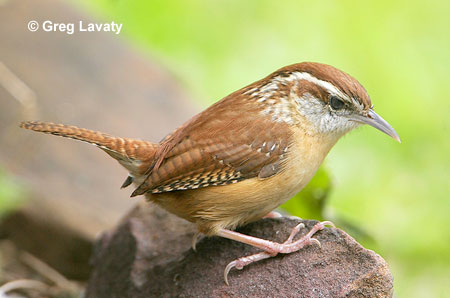
South Carolina is a medium-sized state on the southeastern coast. Bordered by North Carolina and Georgia, the Palmetto State boasts 32,000 square miles of coastline, marshes, cypress swamps, and pine forests. A tiny bit of the Blue Ridge Mountains also occur in South Carolina, and 5,270,000 people live in the state’s farmlands, towns, and cities.
There are 449 species on the birds of South Carolina list, including the South Carolina state bird, the Carolina Wren. Compared to other states, this is the 27th largest bird list.
In this article, you’ll find all the necessary birding information about South Carolina – from the most common birds to hawks, and owls.
On this page
Most Common Birds of South Carolina
According to the North American Breeding Bird Survey from 2021, these birds are the most common bird species in South Carolina.
Learn all about these beautiful South Carolina birds below!
Northern Cardinal
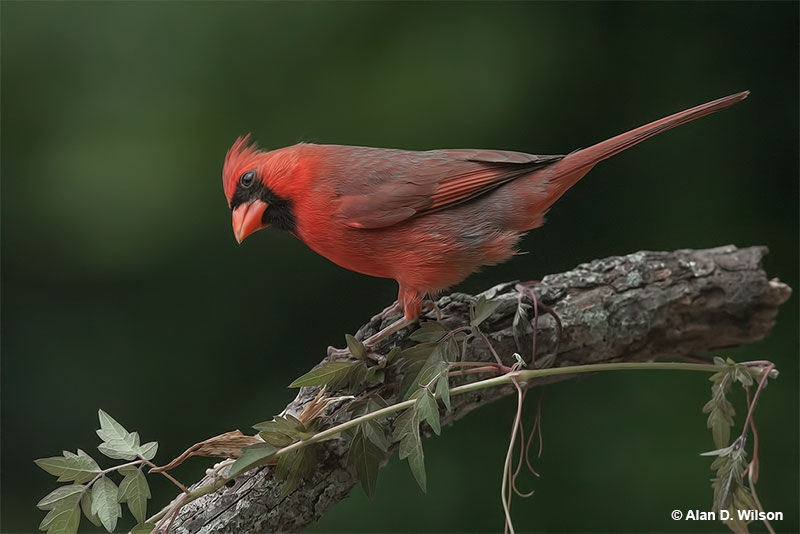
The Northern Cardinal is a striking, finch-like bird around the same size as a thrush. It has a showy crest, and a big, conical orange-red bill. Males are red and have black on the throat and face, and grayish-red on the wings, back, and tail.
Female Northern Cardinals are buff and pale brown with red in their wings, tail, and crest. They also have less black on the face and throat. Young birds have a crest and dusky gray plumage. In bounding flight, Northern Cardinals show a longish, rounded tail.
Northern Cardinals eat a variety of seeds and fruit including Sedges, Sumac, and Dogwood. In the warmer months, they also feed on flower buds, and many insects. This beautiful bird species uses its bill to pick food items from the ground and from leaves and branches.
Its happy, whistled song is frequently heard in gardens, second growth, and other habitats throughout South Carolina.
American Crow
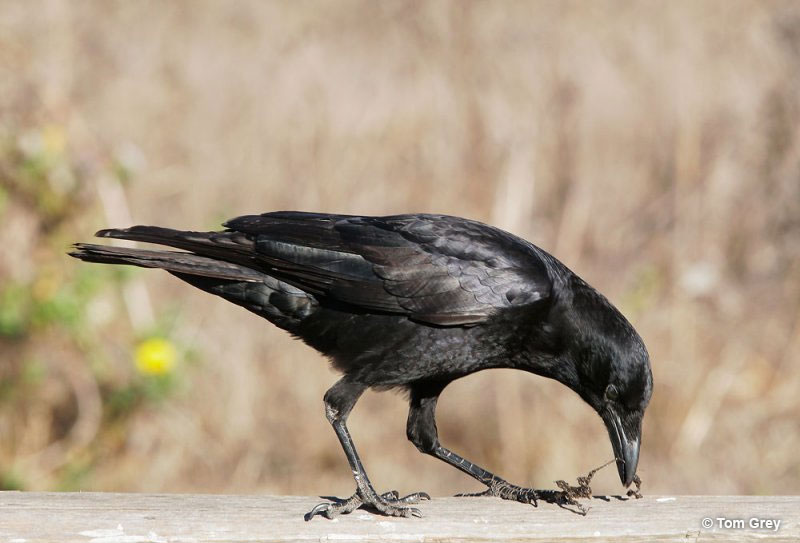
© Tom Grey
The American Crow is a big, loud, all-black bird. Males and females are entirely black and have a strong, stout bill with a slightly hooked tip. At times, they show some deep purple or dark blue highlights but mostly appear dull black.
This species has long wings that almost reach the end of its broad, squared tail. They also have feathers on the upper part of the bill. American Crows are very vocal and frequently given the familiar “Caw! Caw! Caw!” call.
The American Crow has a varied diet. These adaptable birds eat nuts, grain, fruit, insects, young birds, bird eggs, other small animals, garbage, and carrion.
They can eat food while perched but mostly, American Crows forage while walking on the ground. This intelligent species gives alarm calls when they see a person or other animal deemed to be a threat. They are very social birds often seen in flocks and live in habitats throughout South Carolina.
Mourning Dove
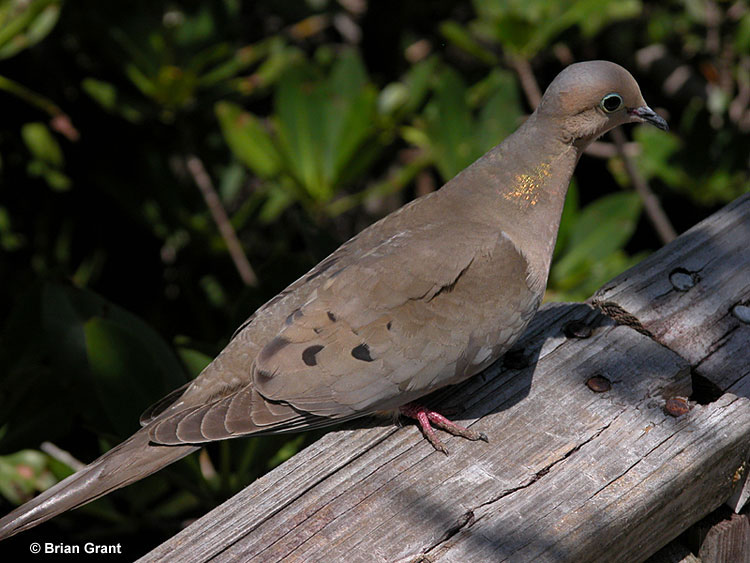
The Mourning Dove is a buff, brown and gray dove species with a long, pointed tail. It has a dainty round head, a slender, black beak, and gray eyering. It also has black spots in the wings, and gray on the back, rump, and tail.
Mourning Doves also have white in their long tail, and males have a black mark on their face and a patch of golden iridescence on the side of the neck. Females look similar but are duller and browner.
Mourning Doves mostly feed on seeds and grain. They often visit feeders and can perch on the feeder or pick up food from the ground. Away from feeders, these birds feed on the ground in open areas.
In South Carolina, the Mourning Dove is a common species of woodlands, farm fields, urban areas and other habitats. We often hear this bird’s sad, owlish vocalization, “who WHO who hoo hoo”.
Carolina Wren
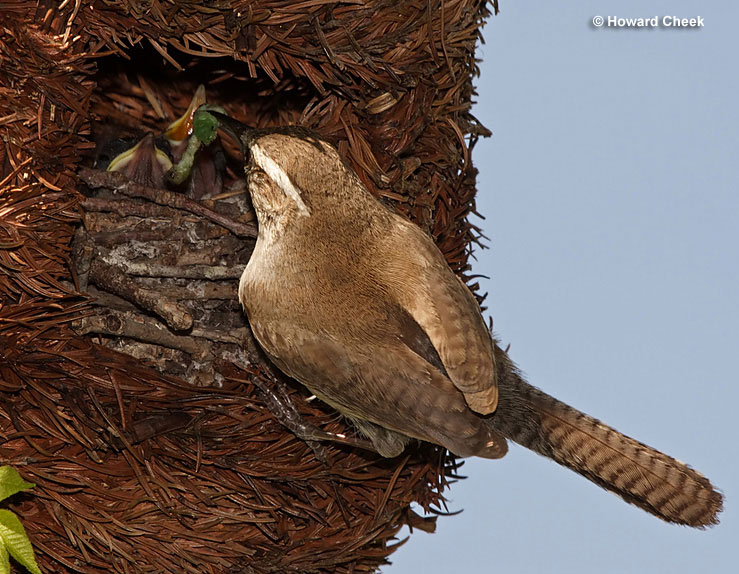
The South Carolina state bird is a small to medium-sized wren with reddish-brown upperparts and rich buff underparts. Males and females look the same and have a white throat, a mottled white face, and a prominent, long, white eyebrow.
They also have a bit of white and black barring in their short, rounded wings, and longish tail. These small birds use their long, grayish bills to pick insects and other small creatures from vine tangles, leaves, and other types of vegetation.
They forage by exploring vegetation in bushes and low trees. Although Carolina Wrens can also forage on the ground, these small birds usually stick to low and mid-height vegetation.
This species doesn’t typically flock with other birds but can join them when mobbing a snake or other predator.
Carolina Wrens usually occur in pairs and often sing. Their “teakettle, teakettle, teakettle” song is a familiar sound in habitats throughout the state of South Carolina.
Carolina Wren is also a State Bird of South Carolina
Northern Mockingbird
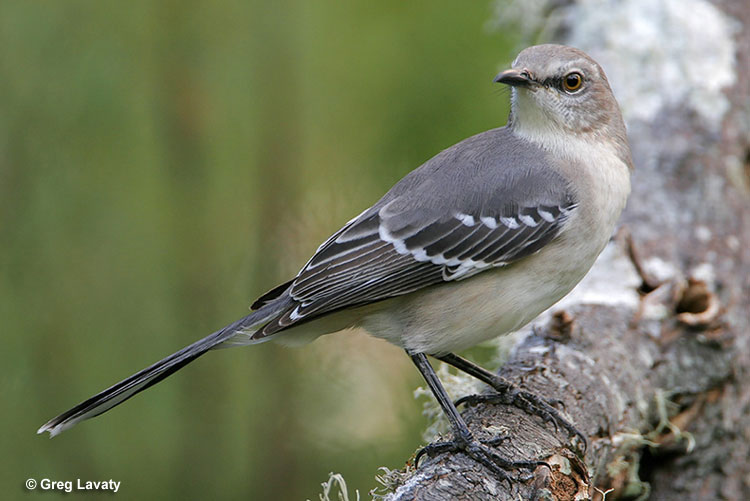
The Northern Mockingbird is a pale gray and white bird with a long tail. Around the same size as an American Robin, this conspicuous species is gray above, pale gray and buff below, and has a white throat. Northern Mockingbirds also have a pair of white wings bars, a broken, narrow white eyering, and some black in front of the eyes.
Males and females look similar. This bird has white in its long tail, yellowish eyes, and a short, dark, slightly curved beak. Juveniles resemble adults but are paler, have paler bills, and some spotting below.
The Northern Mockingbird feeds on many insects and also takes fruit. They catch insect prey after running and stooping to pick them from the ground, and by sallying into the air to catch them on the wing. It eats berries and other fruits while perched.
Northern Mockingbirds can also imitate more than 100 species and their impressive songs are heard throughout South Carolina.
Tufted Titmouse
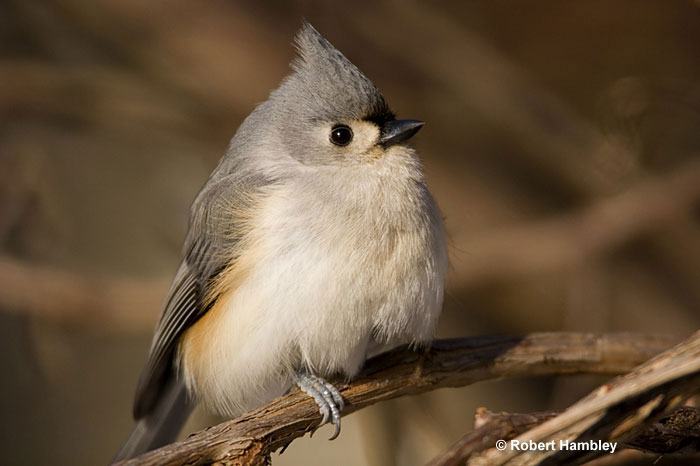
The Tufted Titmouse is a small, crested, pale grayish bird. Males and females are plain, blue-gray above, have a bit of black above a stubby black bill, and white face.
They also have white underparts with peach-orange on the flanks, and some white edging in the wings. Their beady black eye on a pale face and overall appearance make the Tufted Titmouse a good contender for “cutest bird at the feeder”.
The Tufted Titmouse feeds on seeds and insects. It finds food by moving through vegetation and picking bugs from the bark and foliage. To eat a tough seed, it holds it with its foot and hammers it open with its beak.
This species is a common feeder bird and is also seen foraging with chickadees, warblers, and other small bird species. In South Carolina, we hear its cheerful whistled, “peter, peter, peter” in parks, gardens, and woodlands throughout the state.
Blue Jay
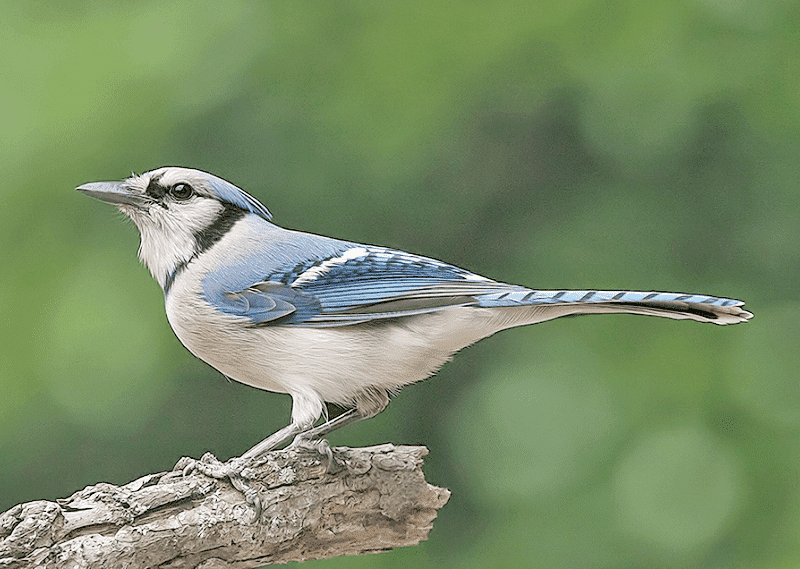
Photograph © Alan Wilson.
The Blue Jay is a medium-sized, beautiful, crested jay with a stout black beak, and gray and blue plumage. It has brighter, turquoise blue in its wings and tail, a pale face, and a white throat bordered with a thin black line.
It also has a black line in front of the bill and on the back part of the face. Both sexes look the same and have rounded wings with black barring and white marks, and long tails. The breast and belly are pale gray and white.
Blue Jays feed on seeds, acorns, and other nuts. They also like cicadas, dragonflies, and other large insects. In common with other jays and crows, Blue Jays can also feed on carrion, nestlings, bird eggs, and other small animals.
These smart birds can catch insects on the wing and also pick food items from foliage, the ground, and feeders. They are very social and are seen and heard throughout South Carolina.
Pine Warbler
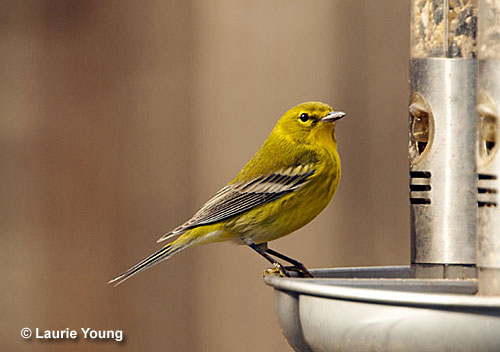
Pine Warbler
The Pine Warbler is a small, yellow and olive bird with a slender dark beak. It has yellow on its face, throat, and breast, and a white belly. This species also has white under the tail.
Pine Warblers have narrow, broken eyerings, olive upperparts, and some olive streaks on the breast. Their long wings are blackish and have two white bars. Female birds look like males but are duller. Juveniles are even duller and look like grayish warblers with white wing bars.
Related: Do ducks live in South Carolina?
Pine warblers feed on small insects and larvae. They forage for them by moving through evergreens and picking the small creatures from pine needles and bark. They often forage high above the ground but can also occur much lower.
Pine Warblers have a brief trilled song commonly heard during spring and summer in South Carolina. It is a very common species in pine woodlands throughout the state.
Red-bellied Woodpecker
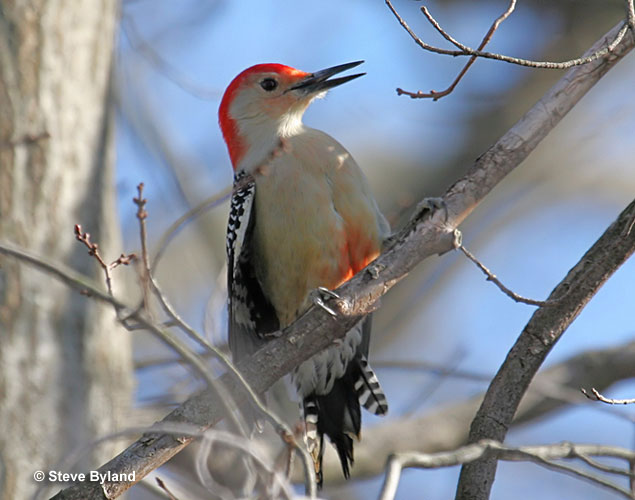
Red-bellied Woodpecker
Despite its name, the Red-bellied Woodpecker doesn’t have too much red on its belly.
The male of this medium-sized woodpecker species has a red crown and nape. The female looks like the male but only has red on the nape and above her long, dark beak.
Like other woodpecker species, they have long, pointed tail feathers to support them as they cling to tree trunks. In flight, Red-bellied Woodpeckers have white crescent-shaped patches on in each wing.
The Red-bellied Woodpecker feeds on fruit, seeds, nuts, insects, and other small creatures. It picks food off branches and tree trunks, and by pecking into wood.
In South Carolina, the Red-bellied Woodpecker is one of the more common woodpecker species. It often visits feeders and is seen in woodlands throughout the state.
Carolina Chickadee
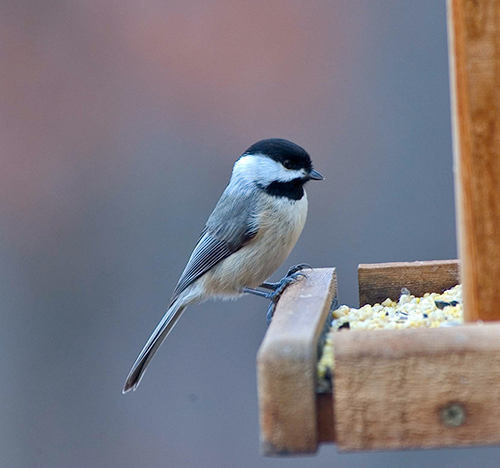
The Carolina Chickadee is a small, cute and friendly bird of woodlands, parks, and gardens. Males and females look the same and have a jet black cap, white face, and black throat. They are gray above and pale gray and buff below. These small birds have short gray wings with some white edging in the feathers, and a medium-length, grayish tail.
Carolina Chickadees feed on small insects and seeds. They find food by exploring bark, twigs, and foliage. They can make acrobatic moves to reach food, often using their strong legs and feet to hang from a twig. These birds are also common visitors to feeders where they feast on seeds and suet.
The Carolina Chickadee is a social bird that usually occurs in small groups. As they move through parks and other habitats, we often hear their nasal “dee-dee-dee” call and “see-bee, see-bew” vocalizations. Carolina Chickadees occur throughout South Carolina.
Eastern Towhee
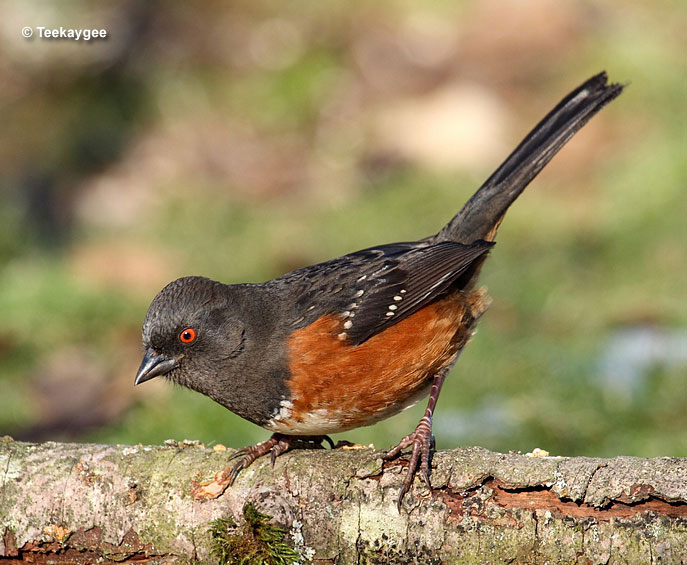
The Eastern Towhee is a slender, sparrow-like bird with a black, conical bill. Around the same size as a thrush, the male has reddish eyes and a jet-black head, breast, and upperparts.
It has white on its belly, chestnut flanks, and peach-orange under the tail. The black wings have white markings, and it also has white spots on the underside of the tail.
Female Eastern Towhees look like males but are dark brown instead of black. This species feeds on insects and seeds. It forages by hopping in a line and picking up bugs and other food with its bill. This species also scratches the ground with its feet to move leaves and reveal insect prey.
Eastern Towhees also feed on berries and insects in low bushes. In South Carolina, the cheery “drink your tea!!” song of the Eastern Towhee is commonly heard in dense, brushy habitats throughout the state.
Indigo Bunting
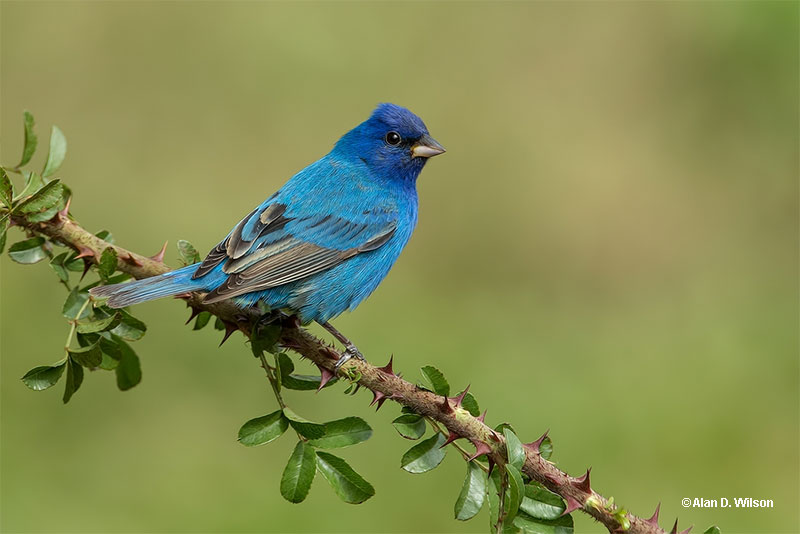
© Alan D. Wilson
The Indigo Bunting is a small, finch-like bird with a conical, gray bill. The male Indigo Bunting is one of the more beautiful birds of South Carolina.
It is a deep, sapphire dark blue with black highlights in his wings, tail, and on his face. Female Indigo Buntings are pale brown with bits of blue on their wings, rump, and tail. She also has diffuse brown streaking on pale underparts.
Male Indigo Buntings can also appear entirely black or show different shades of blue. This is a result of the way colors are produced in the plumage of this and other blue species. Instead of having pigment, the blue we see is generated by the way light interacts with feather structure.
Indigo Buntings eat insects and seeds. They pick their food from low vegetation and prefer brushy habitats. In spring and summer, the chirping and warbling song of this species is often heard in South Carolina.
Common Grackle
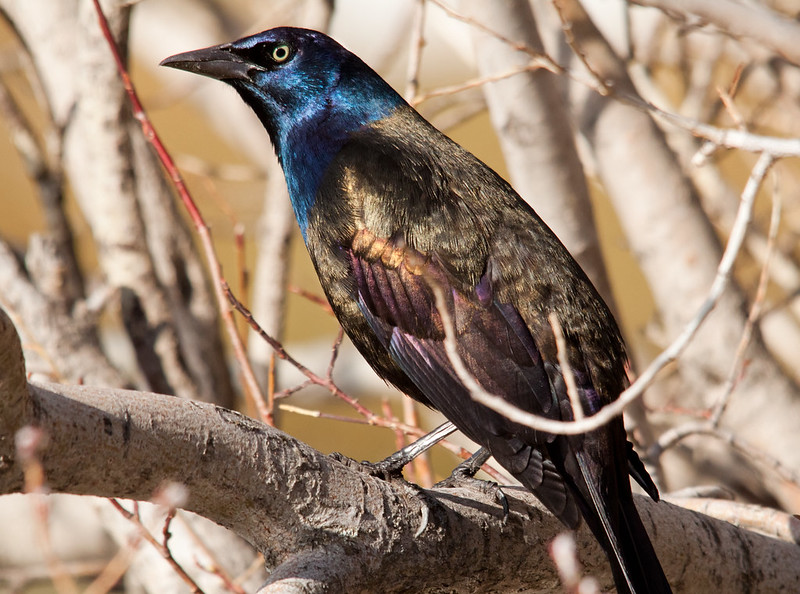
© Shawn McCready
The Common Grackle is a large blackbird with a long, wedge-shaped tail, and pale eyes. A bit bigger than a Blue Jay, male and female Common Grackles are black with bronze, dark green, purple, and dark blue metallic highlights.
It has a strong, hefty beak, fairly long legs, and medium length wings. The female Common Grackle resembles the male but has less iridescence and a shorter tail. This blackbird has become adapted to living near people and is often seen in suburban areas. It feeds on everything from seeds and grains to insects, fruit, and small animals.
Common Grackles usually forage by walking on the ground. They pick up food items with their pointed bills in farm fields, lawns, and other open habitats.
These social birds flock with other Common Grackles, other blackbird species, and Starlings. In South Carolina, the Common Grackle is a common bird species of parks, towns, and other habitats.
White-eyed Vireo
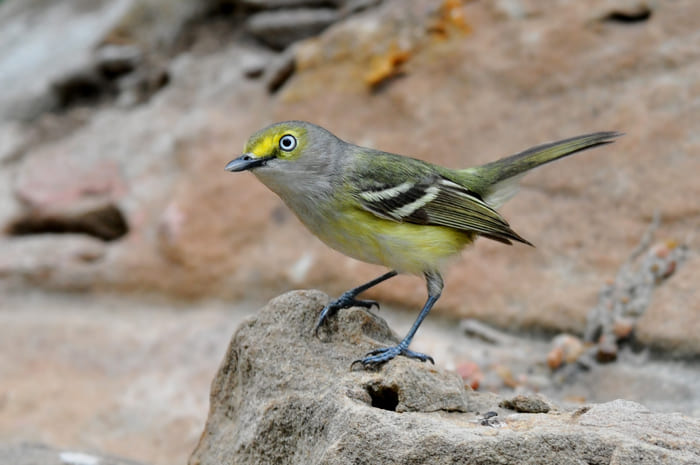
The White-eyed Vireo is a small, pale bird with bright yellow spectacles, a white eye, and an olive and gray head. It has a gray bill with a tiny hook on the tip, two white wing bars, and pale underparts with yellow flanks.
Both sexes of the White-eyed Vireo look the same and also have gray-olive upperparts, and an olive tail. These small birds feed on insects and larvae. In fall and winter, young White-eyed Vireos have dark eyes and pale gray heads. Some also have white spectacles.
They forage by moving through bushes and other low vegetation and picking food from leaves and other hiding places. White-eyed Vireos frequently sing a quick and distinctive chattering song, “chick per wee of chick!”.
These smart-looking little birds are commonly heard and seen in brushy habitats throughout South Carolina. In fall, most migrate south but some spend the winter in brushy coastal habitats.
Chipping Sparrow
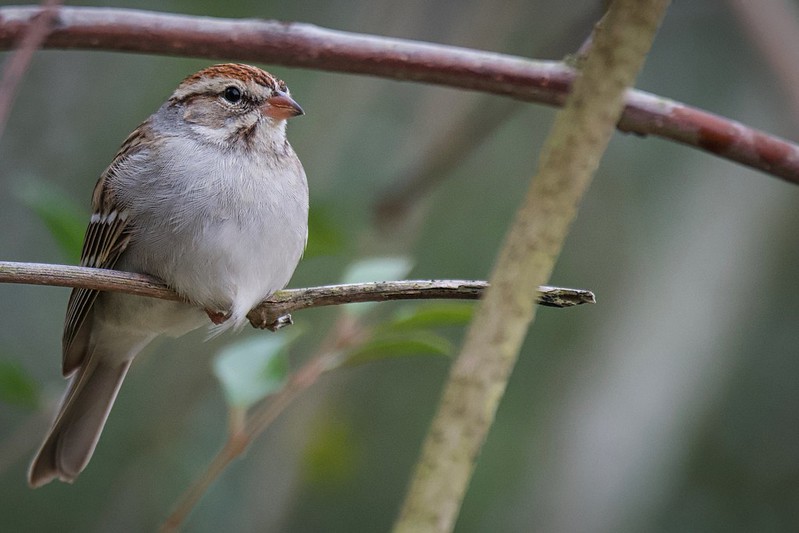
© Kevin Milazzo
The Chipping Sparrow is a small sparrow with a slight, conical bill. Both sexes look the same and have reddish caps, a black line through the eye, and white eyebrows. This species also has eyes with white crescents and gray on its face and neck.
Chipping Sparrows have gray underparts and gray on the lower part of the back and the rump. Their upper back has brown with black streaking, and they have a fairly long, gray-brown, forked tail.
This bird species has black marks and two white wing bars on its rounded wings. In fall, Chipping Sparrows have brown caps and buff eyebrows.
The Chipping Sparrow picks insects and seeds from the ground in open areas with short grass. In South Carolina, it is a common bird of parks, piney woods, and other semi-open habitats with evergreens.
Its mechanical trilled song is often heard in spring and summer but most migrate south for the winter.
Great Crested Flycatcher
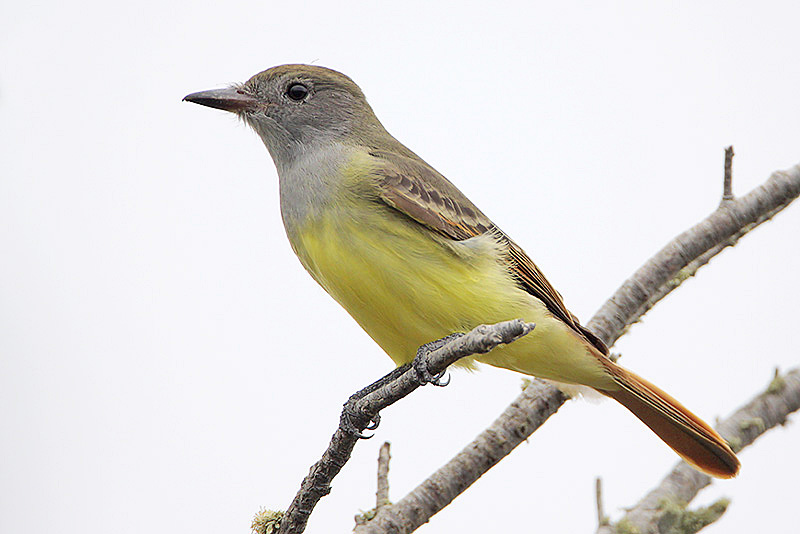
The Great-crested Flycatcher is a hefty flycatcher species with a bushy crest and olive-brown upperparts. Male and female birds look alike and have a gray throat and breast, yellow belly, and reddish-brown in the wings and tail.
Its wings also have two pale wing bars and some white edging in other feathers. Its large beak is dark grey with a pale pinkish base.
This flycatcher species feeds on a wide variety of insects. It also eats small fruits, especially on its tropical wintering grounds. Great-crested Flycatchers sally from a perch to catch insects in the air and from vegetation. To eat fruit, they pick the food item while hovering in front of it.
This species is a common summer resident in woodlands and other wooded areas throughout South Carolina. As long as mature Live Oaks and other large trees are present for nesting, it can even thrive in urban areas.
Cattle Egret
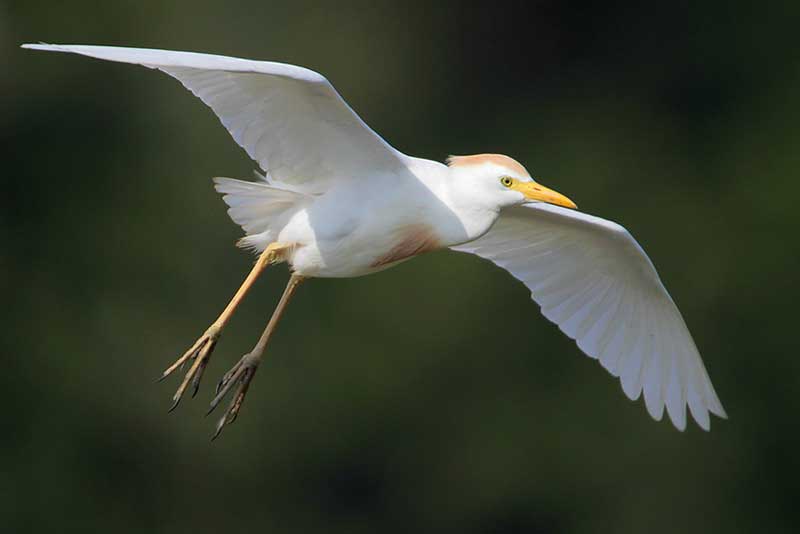
The Cattle Egret is a medium-sized, stocky white heron with a fairly stout, yellow-orange beak. Male and female Cattle Egrets look alike and have long, broad wings, and broad, squared tails. In spring and summer, they have white plumage with pumpkin orange on the head, breast, and back.
At this time of year, they also have bright orange beaks and orange legs. After breeding, Cattle Egrets are entirely white, have more yellowish beaks, and dark legs.
This species is native to Africa but colonized South America and then the USA in the 1950s. Adapted to feeding with cows and other large mammals, Cattle Egrets follow them around to catch frogs, insects, and other small creatures that the big animals scare out of hiding.
The Cattle Egret is a social bird of wetlands and pasture. In South Carolina, flocks are seen throughout the state in suitable habitat. In fall, most migrate south for the winter.
Common Nighthawk
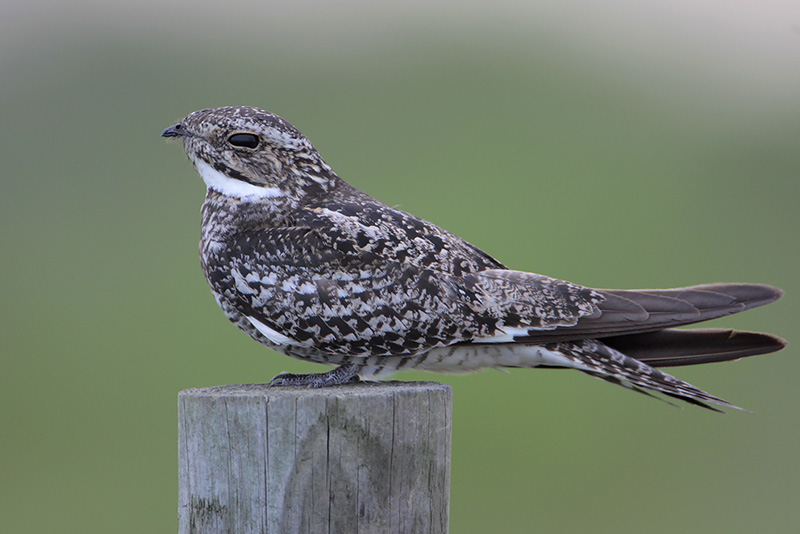
Photograph © Greg Lavaty.
The Common Nighthawk is a mottled buff, white, and gray bird with long, pointed wings. Although it has “hawk” in its name, this species is not a raptor. It is a type of “nightjar”, a family of nocturnal birds that feed on insects.
Common Nighthawks have a white crescent at the base of their black primaries. They also have white in their long, forked tails. Male and female birds are mottled brown, gray, and black above, and are buff below with fine black lines.
Males differ by having white throats. Female Common Nighthawks have buff throats and less white overall.
Common Nighthawks eat insects. They “hawk” for them while flying back and forth over every habitat in South Carolina. Although they are nocturnal, we can also see this species at dawn, dusk, and occasionally during the day.
Its nasal “peent” vocalization is a common feature of summer nights in most of the state.
Hawks in South Carolina
Red-shouldered Hawk
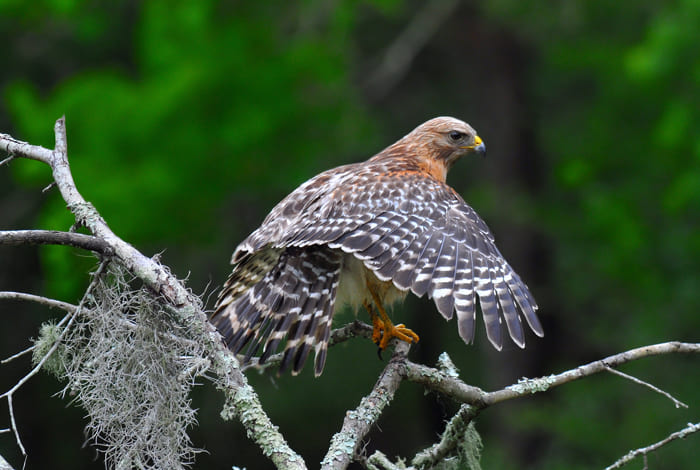
The Red-shouldered Hawk is a striking, medium-sized raptor with long, broad wings, and a fairly long tail. Adult Red-shouldered Hawks have an orange breast and orange barred underparts. Their head and back are reddish brown with dark streaks, and they have a dark border on each side of their pale throat.
This raptor’s blackish wings have reddish shoulders and white markings, and their black tail has white bands. Both sexes are similar but, as with other hawks, females are larger than males.
Young birds lack the bright colors of the adults, have browner plumage, and brown streaks on pale underparts. All ages of the Red-shouldered Hawk can be told in flight by white bands in a fairly long, dark tail, and a pale, crescent-shaped mark at the base of the primaries on each wing.
The Red-shouldered Hawk eats small animals caught on the ground. In South Carolina, the jay-like calls of this common raptor are heard in woodlands throughout the state.
Broad-winged Hawk
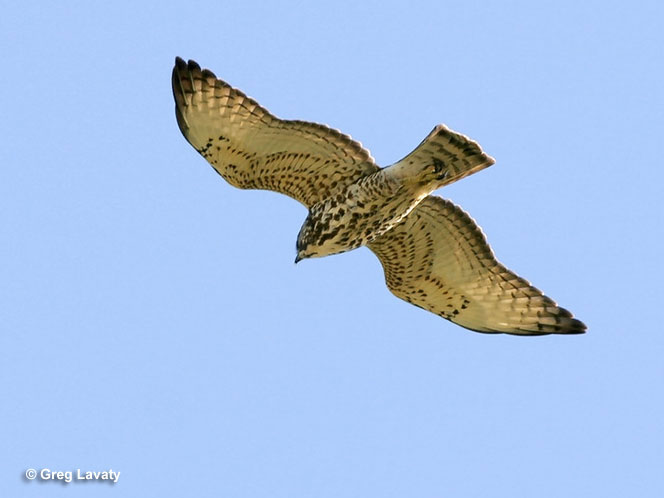
The Broad-winged Hawk is a smallish, crow-sized raptor with long, broad wings, and a broad tail with thick white bands. This small hawk is mottled brown above and has reddish-brown marks and barring below, especially on the breast. With a close view, we can see a thick dark mark on each side of its white throat.
In flight, the wings have a distinctive shape like a “paring knife”. They also have a black border on the flight feathers or trailing edge of the wings. Juveniles resemble adults but have brown streaks on pale underparts.
These small hawks feed on frogs, small mammals, and other small animals. They find food by waiting on a perch and then dropping to the ground to catch the animal with their talons.
In South Carolina, soaring Broad-winged Hawks are often seen and heard over woodlands and forest throughout the state. In fall, they migrate south for the winter.
Red-tailed Hawk
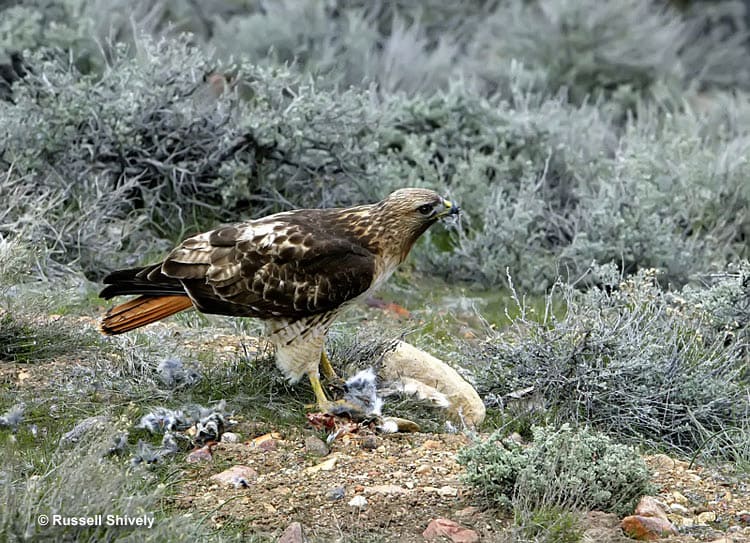
The Red-tailed Hawk is the most common of the hawks in South Carolina. This large and stocky raptor has brown upperparts, a broad reddish tail, and a dark “belt” on its pale belly. Adults of both sexes are similar except that males are a bit smaller than females.
Young birds have the same shape as adults but have a brown tail with some dark bands.
The Red-tailed Hawk feeds on a variety of small animals. It drops down from a perch or from soaring flight to catch chipmunks, rats, snakes, and other prey with its sharp talons.
This adaptable species uses a wide variety of habitats. It can be seen in wooded areas, farmlands, coastal swamps, and even in cities. In South Carolina, the raptor-like scream of the Red-tailed Hawk can be heard in many places. It is also frequently seen perched on roadsides or soaring overhead throughout the state.
Cooper’s Hawk
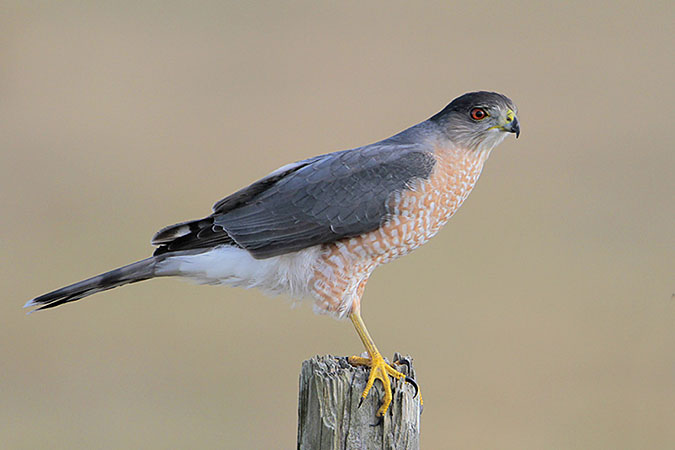
The Cooper’s Hawk is a fair-sized, long-tailed hawk with a blocky, square-shaped head. It is slate blue-gray above, has orange barring below, and a long, rounded tail with dark barring.
Females are larger than males but otherwise, adults look the same. Young Cooper’s Hawks are mottled brown above with some white markings and have dark brown streaks on white underparts.
Like other Accipiter species, the flight profile of the Cooper’s Hawk is one of a few deep flaps followed by brief glides.
This species feeds on squirrels, doves, and other medium-sized mammals and birds. It catches them by surprise after a quick dash from cover, or by flying along and noticing a vulnerable animal in the open. This raptor often attacks birds at backyard feeders.
In South Carolina, the Cooper’s Hawk lives in wooded and semi-wooded areas throughout the state. It has become accustomed to people and lives in most towns and cities.
Sharp-shinned Hawk
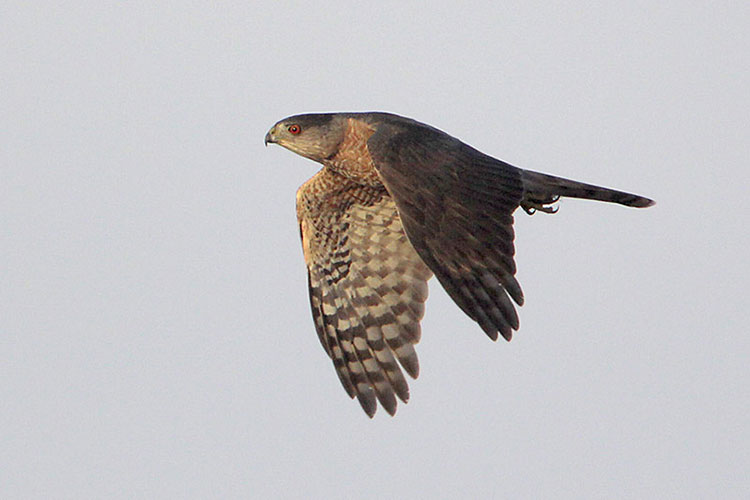
Sharp-shinned Hawk
The Sharp-shinned Hawk is the smallest of the hawks of South Carolina. The males of this raptor can be the same size as a Blue Jay, and the females around the size of a dove. Adult birds are slate blue-gray above and have orange barring below. They have dark bands on a long, square-tipped tail, and rather short, rounded wings.
Juvenile Sharp-shinned Hawks are shaped like adults but are brown above and pale below with dark streaks.
This species only feeds on small birds. It goes after warblers, goldfinches, and any other small bird it can catch. Sharp-shinned Hawks catch their avian prey by watching from a concealed spot and then dashing out to catch the bird. They also fly along and catch birds by complete surprise.
In South Carolina, the Sharp-shinned Hawk only nests in the Blue Ridge Mountains but occurs as a common migrant and winter resident in various habitats in the rest of the state.
Northern Harrier
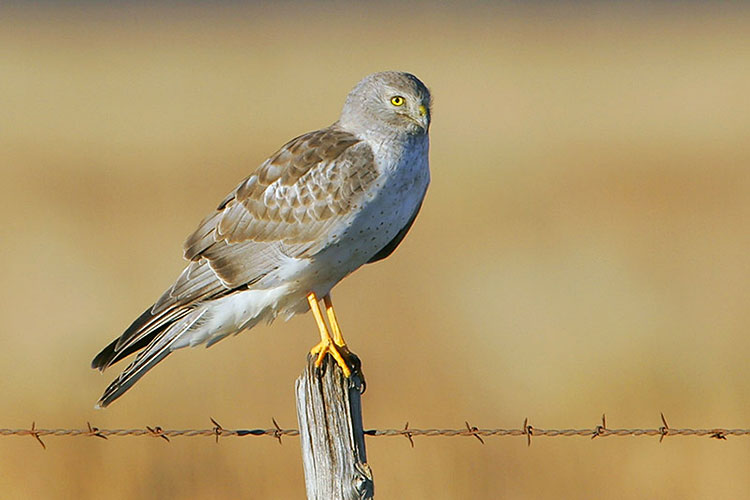
The Northern Harrier is a large and lanky raptor with long wings and a long, barred tail. The male has a gray hood, gray upperparts, and has some brown markings on white underparts. In flight, he has black wing tips and an obvious white rump.
The female Northern Harrier has mottled brown upperparts and brown streaks on white underparts. Young birds are like females but are more reddish-brown and lack streaks.
All sexes and ages of this distinctive species are easily recognized by the white rump, long tail, and long wings held in a “V” shape. This species is often seen in flight as it forages over marshes and open fields.
Northern Harriers flap and glide low over the ground. When they detect a mouse or other small animal, they drop down to catch it. In South Carolina, this elegant raptor is a migrant and winter visitor to coastal marshes and open fields.
Keep reading: Hawks in South Carolina
Owls in South Carolina
Great Horned Owl
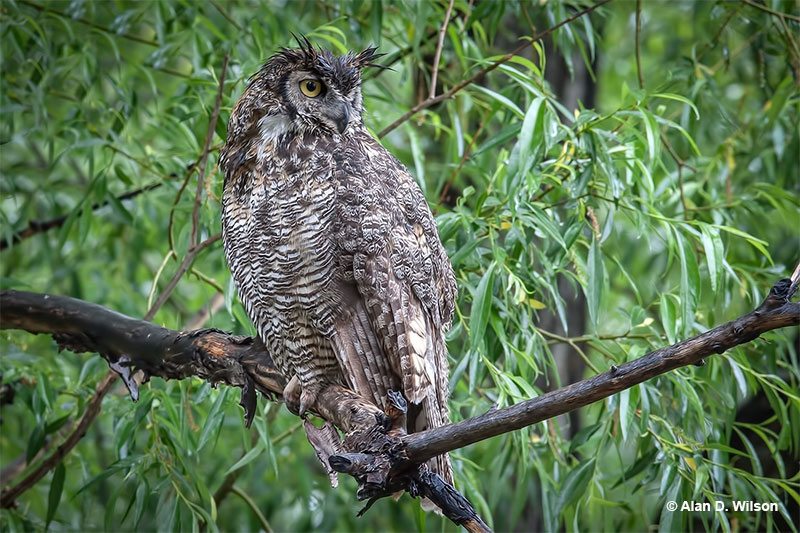
The Great Horned Owl is one of the most powerful raptors in South Carolina. As large as a big Red-tailed Hawk, the Great Horned Owl is a bulky, mottled gray and brown owl species with “ear tufts” or “horns”.
It has a white patch on the lower part of the throat, and an orange or red-brown face bordered with black. This owl species also has yellow eyes, a sharp black bill, and fine dark bars on grayish-brown underparts. In common with other owls, females are bigger than male birds. It also has long, broad wings, and black bands on its broad tail.
The Great Horned Owl feeds on many animals. It can eat everything from small birds to occasional domestic cats and even Great Blue Herons. However, it mostly eats rats, rabbits, squirrels, and other small to medium-sized animals.
In South Carolina, the deep hoots of this species are heard in every habitat in the state.
Eastern Screech-Owl
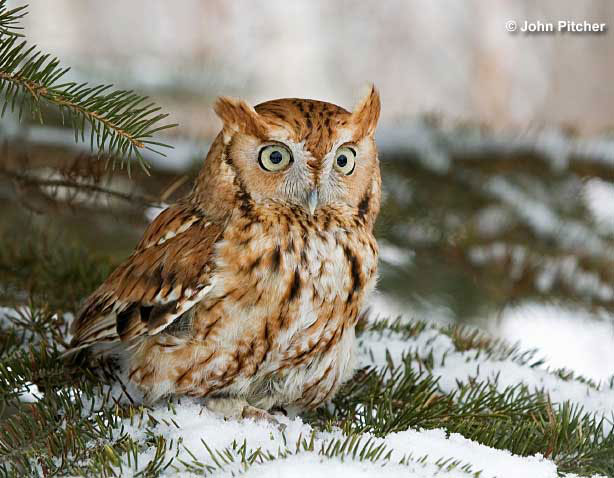
The Eastern Screech-Owl is a small, chunky owl with ear tufts that look like horns. It is mottled brown and gray above with some white spotting in its long wings. This owl also has a pale mottled face partially bordered with black, yellow eyes, and a broad tail with dark barring.
The underparts of the Eastern Screech-Owl are white with a lot of dark streaks and barring. Both sexes look alike but females are slightly bigger. This cute little owl can also be mostly reddish-brown, brown, or gray.
This small owl species is totally nocturnal and feeds on small rodents, insects, and other small animals. It forages by swooping down from a perch to catch the animal on the ground.
The Eastern Screech-Owl might be the most common of the owls in South Carolina. It hides very well but its quavering whinny calls and trilling song can be heard in wooded areas throughout the state.
Barred Owl
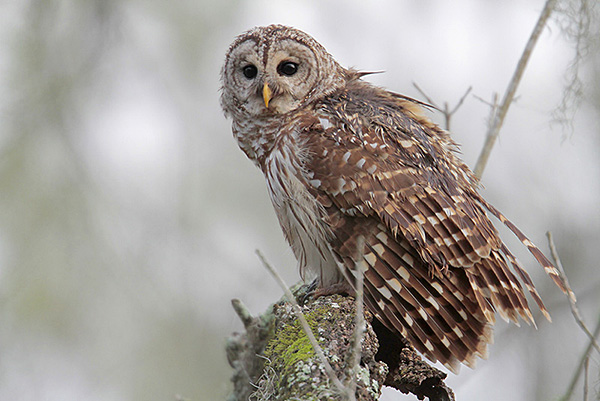
Photograph © Greg Lavaty.
The Barred Owl is a big owl species with a round head and dark brown eyes. It also has a dark border on its pale face, white markings on gray-brown upperparts, and pale underparts with dark brown streaks. This species has long, broad wings, and a broad, dark brown, banded tail.
Males and females are similar but, as is the case for most owls, males are smaller than females.
Barred Owls feed on many animals. They catch crayfish, rats, mice, chipmunks, squirrels, insects, and occasional birds.
This owl species catches prey at night by swooping down onto it from a perch. Although technically nocturnal, Barred Owls are sometimes also active during the day.
Of the owls in South Carolina, this species is one of the most common ones and occurs in wooded areas throughout the state. At night, the “Who cooks for you? Who cooks for you all?” of the Barred Owl is heard in many places.
Short-eared Owl
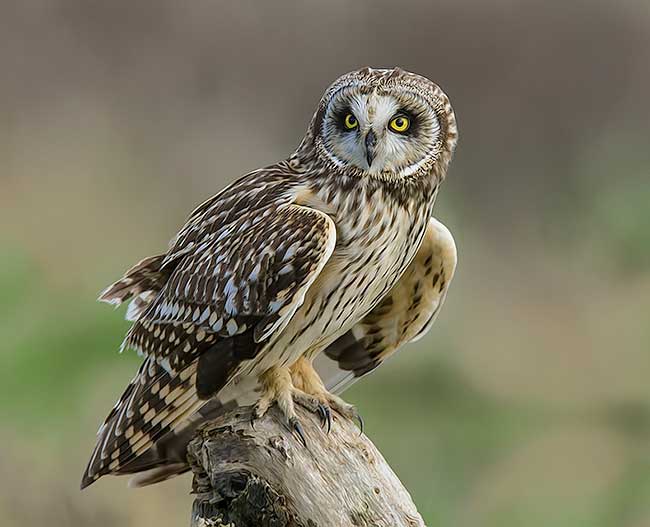
Photos © Alan Wilson
The Short-eared Owl is a medium-sized, brown and buff owl with long wings and a round head. It has a pale face with black around yellow eyes, black beak, and two narrow white lines on the lower edge of each side of the face.
Short-eared Owls are mottled buff and brown above, and are white below with dark brown streaks on the breast. In flight, their wings show buff patches at the base of the primaries. They also have a fairly long, broad, buff and brown tail.
This owl species mostly feeds on mice and other small rodents, and also takes some birds. It forages by flapping and gliding low over weedy fields and other open habitats. When it detects prey, it drops down to catch the animal with its talons.
In South Carolina, Short-eared Owls are uncommon winter migrants. They mostly occur in coastal marshes and other open habitats, and can be seen during the day.
Barn Owl
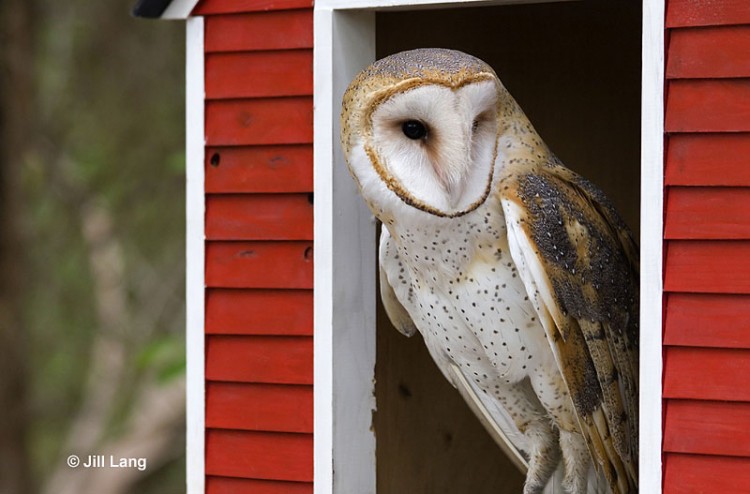
The Barn Owl is a big, white and buff owl. It has a white face shaped like a heart, a rounded head, and gray and orange upperparts peppered with small black and white dots. The underparts of the Barn Owl are white with some dark and buff speckles.
Males are paler than females but are otherwise very similar. This species uses its long, broad wings to silently glide and flap over open habitats in the dark of the night. It uses acute, specialized eyesight and hearing to detect and pinpoint rats and other small animals.
It then drops down to kill the prey item with its long, sharp talons. This beautiful owl lives in areas with fields, marshes, and other open habitats. It can also occur in urban areas and, true to its name, often nests in old barns.
In South Carolina, the screech of the Barn Owl can be heard in most parts of the state.
See more: All the owl species living in South Carolina
Frequently Asked Questions
How many bird species are in South Carolina?
In total, 449 bird species have been found in South Carolina.
What is the most colorful bird in South Carolina?
The Painted Bunting. Male Painted Buntings are bright red, deep blue, and lime green.
What is the largest bird in South Carolina?
The largest bird in South Carolina is the American White Pelican. This big bird is 63 inches long and has a wingspan of more than nine feet! The heaviest bird in South Carolina is the Mute Swan. It weighs more than 25 pounds.
What is the largest raptor in South Carolina?
The Bald Eagle. Bald Eagles are 31 inches long and have a wingspan of more than six and a half feet.

